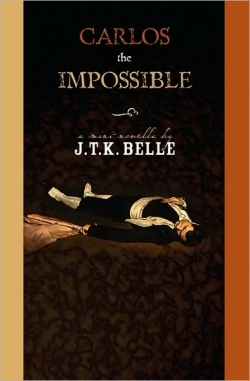Carlos the Impossible
One of the lesser recognized attributes of a novella is the small investment of time needed to dive in, devour, and then be done. If it’s not memorable, no big deal, the experience took less than an hour. But if the short novel is wonderful to read and immensely memorable, as is Carlos the Impossible, the lucky reader finds it effortless to read again and again. Indeed, this simple story of an enormous mellow bull and the jaded, infamous matador who wants to kill him, begs to be read repeatedly.
Hernando, the matador, is at the top of his game when he meets Carlos, the invincible bull, and together they remain, in a strangely intimate dance, until both die of old age and ennui. J.T.K. Belle also weaves a primer in bull-fighting into the plot as a welcome bonus, and though the fantastical, impossible permutations of Hernando and Carlos defy reality, the customs and idioms of the sport feel spot-on accurate.
The first contest between the star-crossed pair sets the stage for their destiny. Fifty thousand people are on hand, and “To the observant aficionados, the bull seemed merely curious of the goings on: the thick padded horses prancing in the ring, the men with long pics mounted atop them, thrusting them toward him awkwardly and from too great a distance, the lone man with bright green eyes standing near the sideboards sizing him up, taking him in.” In what barely passes for a bullfight, but was nevertheless a thrilling spectacle, Carlos accidentally injures Hernando, and, “As they raised Hernando over the rail and hoisted him onto a stretcher, Hernando came to just long enough to pardon the bull. ‘Save this one,’ he said. ‘I will meet with him again.’” Little did he know how true that would be.
Gabriel Garcia Marquez’s gift of mixing magic and the mundane comes to mind, with his exquisite paragraphs that carry on for pages, and Hemingway, too, when he wrote so melodically about hard, masculine subjects. Carlos the Impossible is refreshingly non-violent, though the central theme is Hernando’s obsessive fixation on killing the bull, Carlos. Fortunately, it can’t be done, for Carlos is destined to be Hernando’s lifelong nemesis and companion, as they live out their final decades, alone together in the stable by night and the bullring by day. As Hernando sinks into dementia, Carlos becomes his caretaker, his rock. The ending is both sad and perfect.
This splendid book is appropriate for classroom use in middle school through college, and a Hispanic audience would find it especially enjoyable, as much of the book is set in Mexico and there are many Spanish words.
Reviewed by
Patty Sutherland
Disclosure: This article is not an endorsement, but a review. The publisher of this book provided free copies of the book and paid a small fee to have their book reviewed by a professional reviewer. Foreword Reviews and Clarion Reviews make no guarantee that the publisher will receive a positive review. Foreword Magazine, Inc. is disclosing this in accordance with the Federal Trade Commission’s 16 CFR, Part 255.

